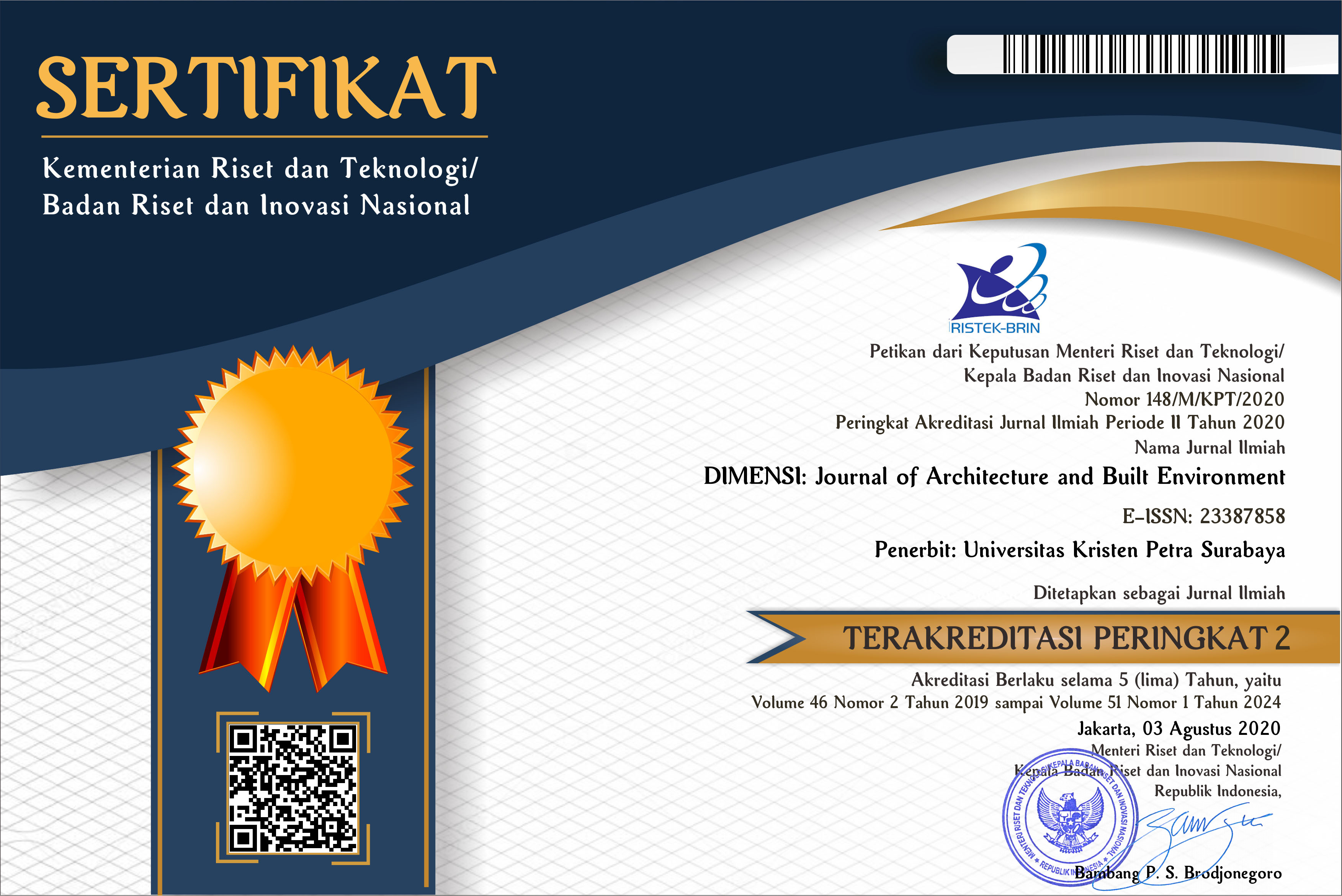UTILIZATION PATTERN OF RESIDENTIAL TERRACE AS A TRADING PLACE IN KAMPUNG TRIDI JODIPAN MALANG
 :
:
https://doi.org/10.9744/dimensi.46.1.51-58
Keywords:
Thematic Kampong, shop-house, terrace utilizationAbstract
Kampung Tridi, Jodipan Malang, which was initially a slum residential area has transformed now into a colorful area with a concept of colorful order, arranged linearly according to the houses pattern. This setting is positively effective to attract tourist interest to come and success in changing the aspect of social, culture and economy of the residents. The aspect which has been through adequate significant change is the economy, which is indicated from the number of residents who take benefit from their house's terrace that initially used as a conventional family area, now turn into an area of trading. This change is conducted to be economic support in order to fulfill their life needs. This research aims to identify the pattern of terrace utilization as the place where the trading activity takes place in Kampung Tridi Jodipan Malang. This research exerts the method of descriptive qualitative which identifies the pattern of terrace utilization through field survey, interview, and literature studies, while the method of analysis used behavior mapping. This research finding shows that the utilization pattern of the residential terrace as the trading spot is located exactly in the front part of the house, that is the terrace. The houses that using the terrace as the trading spot are mostly located in the front of the main path which leads to the Jembatan Kaca (Glass bridge) that connects Kampung Tridi with Kampung Warna-warni in the south.
Downloads
References
Amelia, R., Antariksa, and Suryasari, N. (2015). Tata Letak Ruang Hunian-Usaha Pada Rumah Lama Milik Pengusaha Batik Kalangbret Tulung¬agung. Jurnal Mahasiswa Arsitektur Universitas Brawijaya. 3(2): 1-10.
Fernanda, F., A. L. Kusuma, and U. K. Petra (2017). Kreativitas Masyarakat Kota Malang Dalam Membentuk Identitas Kota. Prosiding Seminar Nasional Seni dan Desain: “Membangun Tra¬disi Inovasi Melalui Riset Berbasis Praktik Seni & Desain” FBS Unesa. 189–195.
Haryadi; Setiawan. B. (2014). Arsitektur Lingkungan dan Perilaku :Pengantar ke Teori Metodologi dan Aplikasi. Kedua, Agu. Gajah Mada Univer-sity Press.
Li, S. (2018). Ecological Design of Lighting and Ventilation in Traditional Shophouses in Urban Southeast Asia. Welsh School of Architecture Cardiff University.
Ningsih, T.R. (2017) Kampung Wisata Warna Warni Jodipan Kota Malang, Berkelanjutan Atau Sementara?. Prosiding Scan#8: Edu¬cation. Putting Eco-Dna In Our Kids” Universitas Atma Jaya Yogyakarta. 155–166.
Putri, T. N., Sidi, B.D., Rahmi M., and Samsirina (2018). Building Facade Transformation of Shophouses Viewed From Sustainability Prin-ciples Case Study: Shophouses in Bandung City. HABITechno 3 International Conference. IOP Conference Series: Earth and Environmental Science. 152: 1–10.
Rapoport, A. (1969). House form and Culture (Foundations of Cultural Geography Series). Englewood Cliffs, N.J.: Prentice Hall.
Silas, J. (2000). Rumah Produktif Pendekatan Tradisi dan Masyarakat. Laboratorium Perumahan dan Permukiman Jurusan FTSP ITS; UPT Pener¬bitan ITS, Edisi Pertama, Surabaya.
Taufikurrahman (2010). Perubahan Pola Tatanan Ruang Rumah Tinggal sebagai Akibat Kegiatan Industri Rumah Tangga (Studi Kasus Pengrajin Logam di Desa Ngingas Kecamatan Waru Kabupaten Sidoarjo). Prosiding Seminar Nasio-nal Perumahan Permukiman dalam Pemba-ngunan Kota 2010. Jurusan Arsitektur ITS. 1-15.
Wahab, S. A. (1990) Analisis Kebijaksanaan dari Formulasi Ke Implementasi Kebijaksanaan Negara. Jakarta; Bumi Aksara.
Wulandari, P. K. (2017). Inovasi Pemuda Dalam Mendukung Ketahanan Ekonomi Keluarga (Studi Di Kampung Warna-Warni Kelurahan Jodipan, Kecamatan Blimbing, Kota Malang). Jurnal Ketahanan Nasiona,. 23(3): 300–319.
Downloads
Published
How to Cite
Issue
Section
License
Authors who publish with this journal agree to the following terms:
- Authors retain copyright and grant the journal right of first publication with the work simultaneously licensed under a Creative Commons Attribution License that allows others to share the work with an acknowledgement of the work's authorship and initial publication in this journal.
- Authors are able to enter into separate, additional contractual arrangements for the non-exclusive distribution of the journal's published version of the work (e.g., post it to an institutional repository or publish it in a book), with an acknowledgement of its initial publication in this journal.
- Authors are permitted and encouraged to post their work online (e.g., in institutional repositories or on their website) prior to and during the submission process, as it can lead to productive exchanges, as well as earlier and greater citation of published work (See The Effect of Open Access).

















